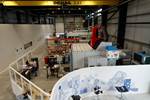A flight plan for next-gen manufacturing
If the commercial aviation industry effectively doubles in the next 20 years, as projected by the two largest aerospace manufacturing companies in the world, how can aerospace manufacturers and suppliers possibly keep up?
If the commercial aviation industry effectively doubles in the next 20 years, as projected by the two largest aerospace manufacturing companies in the world, how can aerospace manufacturers and suppliers possibly keep up? The prediction, made by both Boeing and Airbus, is that the in-service fleet of passenger and freight aircraft will increase from roughly 21,000 today to more than 40,000 by the year 2037, largely to accommodate the expected surge of international travelers from emerging economies. Meeting that demand will require new technologies and unprecedented manufacturing rates. What does that look like?
Read on.
The pages of this publication show more than just a snapshot of aerospace manufacturing as it exists today. Instead, these stories reveal technologies, processes and materials that are poised to accelerate aerospace manufacturing throughput and increase scalability for industry suppliers in the coming years.
Additive manufacturing is fulfilling its promise in the aerospace industry more than any other, as evidenced by more than 300 additively produced parts that help compose the new GE9X engine. On page 6, you’ll learn how GE Aviation has helped create this blueprint for industrialized next-generation aerospace through additive manufacturing. And on page 34, you’ll learn how small-and mid-sized aerospace suppliers can systemize operations for automated and complex machining processes, rather than hiring new employees among the shrinking supply of skilled manufacturing workers.
Together, these and other stories you’ll find form a navigation tool for next-generation aerospace manufacturing. They also provide clues as to how the commercial aviation industry plans to greet the coming wave of travelers.
Related Content
-
Next-generation airship design enabled by modern composites
LTA Research’s proof-of-concept Pathfinder 1 modernizes a fully rigid airship design with a largely carbon fiber composite frame. R&D has already begun on higher volume, more automated manufacturing for the future.
-
First Airbus A350 crash confirmed in Haneda
Shortly after touch-down, a JAL A350-900 aircraft recently collided with a De Havilland Canada Dash 8. Exact circumstances are still unknown.
-
Otto Aviation launches Phantom 3500 business jet with all-composite airframe from Leonardo
Promising 60% less fuel burn and 90% less emissions using SAF, the super-laminar flow design with windowless fuselage will be built using RTM in Florida facility with certification slated for 2030.






